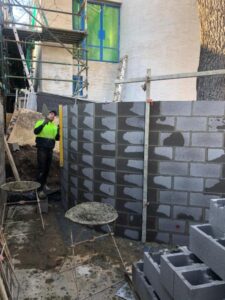The main difference between blocks and bricks is that blocks are larger, often made from concrete or lightweight materials, and are preferred for faster, large-scale construction due to their size and insulation properties, whereas bricks are smaller, typically made from clay or concrete, making them ideal for detailed construction.
Blocklayers will use blocks for commercial construction for their efficiency, strength, and ability to cover large areas quickly.
Our blog will discuss the material composition and structural differences between blocks and bricks in detail.
What’s the Material Composition for Blocks and Bricks?
The material composition for blocks and bricks is different, giving each its unique characteristics and strengths.
Blocks
Concrete blocks are made from a mixture of cement, water, sand, and aggregates. This composition provides blocks with excellent load-bearing capacity and thermal insulation. The aggregates, such as gravel and crushed stone, enhance the block’s durability, making it ideal for foundations, walls, and other structural applications.

Bricks
Bricks are made by moulding clay and firing it in a kiln. This process hardens the clay into a dense, durable material that can withstand significant pressure. The blend of clay and shale determines the brick’s colour and texture, with regional variations offering different aesthetic options. Bricks have great thermal mass, helping to regulate indoor temperatures by absorbing and releasing heat slowly.
Understanding the material composition helps in evaluating the pros and cons of using blocks, such as their suitability for various projects and their environmental impact. Each material has unique benefits and limitations, influencing its use in construction.
Structural Differences and Their Impact on Construction
The structural differences between blocks and bricks are in their size, weight, and how they are used in construction. Blocks are larger and lighter, making them easier to handle and faster to lay. Bricks are smaller, heavier, and stronger, requiring more time and effort to install.
Blocks, being larger, mean fewer joints and less mortar, which speeds up construction and cuts labour costs. Their lighter weight also makes them easier to transport and work with on-site. However, blocks might not look as good as bricks for exposed walls.
Bricks, although smaller, provide great strength, and can be used more easily to create feature walls than blocks due to their size. They offer excellent sound insulation and fire resistance. The variety of brick colours and textures adds to their appeal for both structural and decorative uses. But laying bricks takes more time and effort, which can increase construction costs.
Aesthetic Considerations When Choosing Between Blocks and Bricks
The following are some aesthetic considerations when choosing between blocks and bricks:
- Visual Appeal: Blocks give a sleek, modern look, while bricks have a classic, textured charm while being much more versatile.
- Colour Options: Blocks come in trendy hues, and bricks offer a wide range of colours.
- Texture Variety: Blocks usually have a smooth finish; bricks provide different textures to choose from.
- Pattern Possibilities: Bricks can create intricate, traditional patterns, while blocks work well for simple, modern designs.




